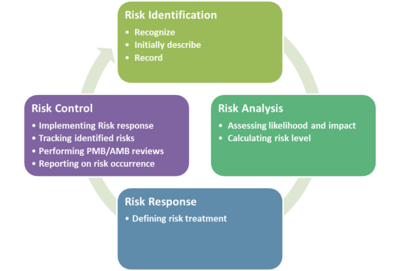EGI-Engage:Risk Plan
Help and support: quality@egi.eu
This page is proving rules regarding risk management within EGI-Engage project.
Definition (iso 31000): risk is defined as the effect of uncertainty on objectives
- Risk identification
- a process that is used to find, recognize, and describe the risks that could affect the achievement of objectives.
- Risk analysis
- a process that is used to understand the nature, sources, and causes of the risks that you have identified and to estimate the level of risk. It is also used to study impacts and consequences and to examine the controls that currently exist.
- Risk treat
- a process that is used to compare risk analysis results with risk criteria in order to determine whether or not a specified level of risk is acceptable or tolerable.
- Risk monitor
- a process which goal is to review of existing Risk database conducted periodically
- a process which goal is to review of existing Risk database conducted periodically
Risk identification
Risk identification process
Risk identification is a process that involves finding, recognizing, and describing the risks that could affect the achievement of an organization’s objectives. It is used to identify possible sources of risk in addition to the events and circumstances that could affect the achievement of objectives. It also includes the identification of possible causes and potential consequences.
You can use historical data, theoretical analysis, informed opinions, expert advice, and stakeholder input to identify your organization’s risks.
Risk analysis
Risk description
Each risk in Risk Management Database is described as follow:
- Risk no - unique risk identifier
- Risk - one sentence description of the risk
- Risk level - (Low/Medium/High/Extreme) The level of risk is its magnitude. It is estimated by considering and combining consequences and likelihoods. A consequence is the outcome of an event and has an effect on objectives. Likelihood is the chance that something might happen.
- Likelihood - (Unlikely, Possible, Likely, Almost Certain) Likelihood is the chance that something might happen.
- Consequences - (Minor/Moderate/Major/Catastrophic) A consequence is the outcome of an event and has an effect on objectives.
- Treatment - (Protective, mitigation measures, recovery activities, controls) description of possible treatment of the risk
- Impact - description of impact risk will have in case of occurrence
- Deliverables - Deliverables which might me impacted in case of occurrence
- KPIs - Impacted KPIs
- WP1-WP6 - Impacted WPs
- Owner - A risk owner is WP that has been given the authority to manage a particular risk and is accountable for doing so.
- Trend - (Stable, Improving, Degrading) Indication of risk trend comparing to previous risk review period
- Comment for PMB - additional comments for PMB after AMB review
Risk treatment
Low/Medium/High/Extreme
Make a Decision: once the above process is complete, if there are still some risks that are rated as High or Extreme, a decision has to be made as to whether the activity will go ahead. There will be occasions when the risks are higher than preferred but there may be nothing more that can be done to mitigate that risk ie. they are out of the control of the work unit but the activity must still be carried out. In such situations, monitoring the circumstances and regular review is essential.
Add other Controls: generally speaking, any risk that is rated as High or Extreme should have additional controls applied to it in order to reduce it to an acceptable level. What the appropriate additional controls might be, whether they can be afforded, what priority might be placed on them etc etc is something for the group to determine in consultation with the Head of the work unit who, ideally, should be a member of the group doing the analysis in the first place.
Retain/accept the risk - if, after controls are put in place, the remaining risk is deemed acceptable to the organisation, the risk can be retained. However, plans should be put in place to manage/fund the consequences of the risk should it occur.
Reduce the Likelihood of the risk occurring - by preventative maintenance, audit & compliance programs, supervision, contract conditions, policies & procedures, testing, investment & portfolio management, training of staff, technical controls and quality assurance programs etc.
Reduce the Consequences of the risk occurring - through contingency planning, contract conditions, disaster recovery & business continuity plans, off-site back-up, public relations, emergency procedures and staff training etc.
Transfer the risk - this involves another party bearing or sharing some part of the risk by the use of contracts, insurance, outsourcing, joint ventures or partnerships etc.
Avoid the risk - decide not to proceed with the activity likely to generate the risk, where this is practicable.
Protective measures: (activities designed to reduce the chances of a disruptive event occurring)
Mitigation measures: (activities designed to minimize the severity of the event once it has occurred.)
Recovery activities: (activities serve to bring back disrupted systems and infrastructure.)
Contingency plans: (process-level documents describe what an organization can do in the aftermath of a disruptive event; they are usually triggered based on input from the emergency management team.)
Controls: (additional controls applied to it in order to reduce it to an acceptable level. What the appropriate additional controls might be, whether they can be afforded.)
Risk monitor
Risk review process
A review is an activity. Review activities are carried out in order to determine whether something is a suitable, adequate, and effective way of achieving established objectives.
In general, ISO 31000 expects you to review your risk management framework and your risk management process. It specifically expects you to review your risk management policy and plans as well as your risks, risk criteria, risk treatments, controls, residual risks, and risk assessment process.
